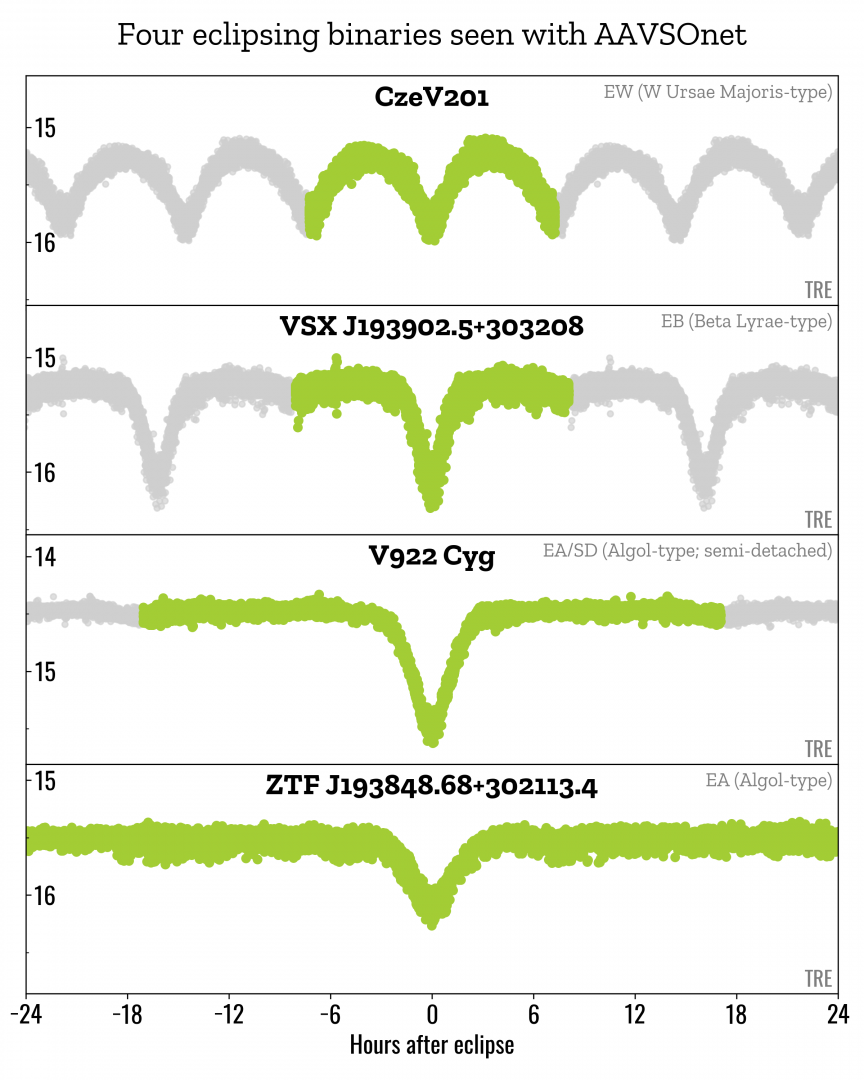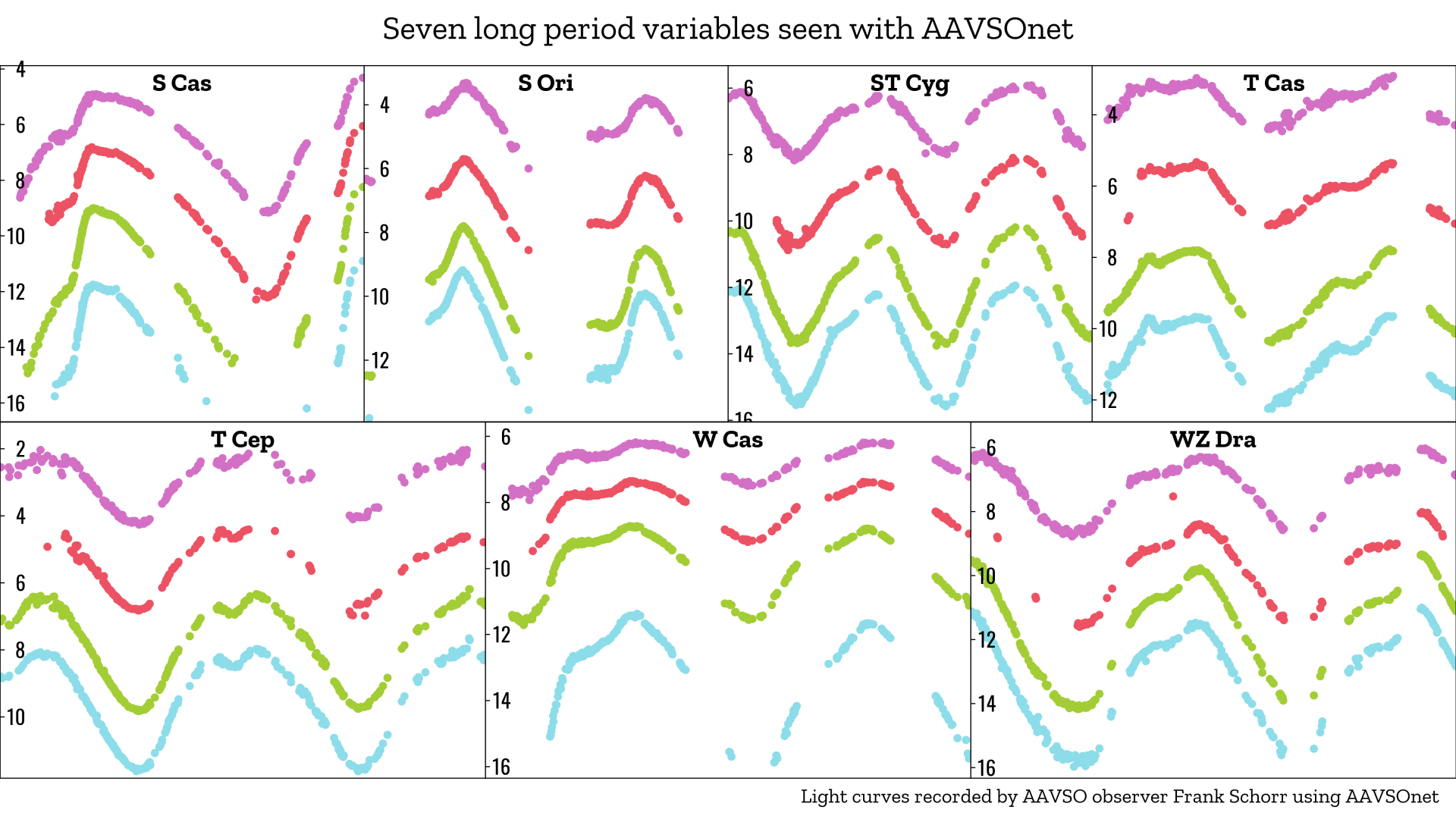Did you know that one of the benefits of AAVSO membership is access to a global network of research-grade telescopes? Ranging from the small and nimble Bright Star Monitors to the 20”+ Faint Star Monitors, our remote telescopes allow anyone, anywhere to record high-quality photometric and spectroscopic data, both for educational and scientific purposes.
Telescope time is awarded based on a simple proposal system. In general, you must be a member of the AAVSO in good standing in order to receive telescope time, but the AAVSO Time Allocation Committee may approve proposals from non-members in exceptional circumstances. Instructions for submitting a proposal can be found below.
Interactive map
Click on each telescope icon to view telescope specs, photos of the observatory, and example results from the telescope.
How to use AAVSOnet
The AAVSOnet telescopes are fully automated. After your proposal is accepted, your target(s) will be added to the queue by AAVSOnet volunteers, and from there your observations will be automatically scheduled by ACP and executed by MaxIm DL. The resulting images will then be calibrated and uploaded directly to your AAVSO VPhot account for you to process. (You may optionally request for the images to be made available for direct download via FTP, as well.)
This automatic process means that as an observer, you only need to do two things: Write a proposal, and process your data.
Writing a proposal
Writing a proposal is as simple as completing the AAVSOnet proposal form.
To learn more about the proposal-writing process, including tips for maximizing your chance of having your proposal accepted, click here.
Processing your data
AAVSOnet images are delivered to you pre-calibrated, with dark, flat, and bias correction already applied. That means that you can skip straight ahead to the fun part: photometry!
Our recommendation for doing photometry is VPhot. VPhot is a powerful, easy to use, web-based photometry tool which is available to every AAVSO member. Your AAVSOnet images will appear directly in your VPhot account.
Click here to access VPhot, view the Users Guide, and learn about upcoming CHOICE courses.
You may also find these resources to be useful for learning how to do photometry with CCD and CMOS sensors like those used by AAVSOnet telescopes:
- AAVSO How-to Hour: How to Start with CCD Photometry
- AAVSO Guide to CCD/CMOS Photometry
- AAVSO Photometry Forum
Don’t forget to submit your data once you’ve finished processing it!
Examples
Using AAVSOnet, you can record data of high enough precision to study all sorts of interesting stars. Here are a few examples drawn from the hundreds of light curves produced by observers using AAVSOnet so far:



Learn more
History
AAVSOnet has been a long time in the making! To read about the history of AAVSOnet, click here.
Forum
On the AAVSOnet forum, you'll find stickied threads containing transformation coefficients for each telescope, as well as frequent status updates by the AAVSOnet team. Questions are welcomed, and we encourage anyone who's interested to join the AAVSOnet Observing Section by subscribing to the forum.
Videos
The AAVSOnet video library page features a number of informative presentations recorded by members of the AAVSOnet team. Here are two of the most recent examples:
|
"AAVSONet Proposals – What, Why and How?" |
"Science with the AAVSOnet Faint Star Monitors" |
Acknowledgements
We gratefully acknowledge the support of Diffraction Limited/SBIG (furnishing cameras, filter wheel, spectrographs, and copies of MaxIm DL); DC3 Dreams (providing ACP and ACP Scheduler); the Tzec Maun Foundation (providing telescopes and mounts on long-term loan); QHY (supplying cameras and filter wheels); QSI Corp (providing cameras); Software Bisque (supplying software); Pierre de Ponthiere (supplying LesveDome); Steve Beckwith (supplying FocusMax); Astrodon (supplying filters); MoonLite (providing focusers and service); and Moonglow (providing all-sky cameras and service). Without this kind of vendor support, AAVSOnet would not be a reality.
We also gratefully acknowledge the impactful contributions of several major financial donors, including Richard Berry (who contributed BSM-Berry in honor of Martin Bruce Berry); John Centala; Dick Post; and Bob Stine (who contributed BSM-Hamren in honor of Merle R. Hamren). Thanks to their generous support, AAVSOnet has been able to flourish and grow.
In addition, AAVSOnet depends heavily on the time, money, and hardworking dedication of many volunteers, including site managers (Greg Bolt, Dave Cowall, John Gross, Arne Henden, Peter Nelson, and Bill Stein), telescope operators, image inspectors, and IT/pipeline developers. It is thanks to these volunteers’ invaluable efforts that AAVSOnet thrives today, giving the gift of data to variable star enthusiasts all around the world.
We are always open to introducing new telescopes to the network. If you are interested in volunteering, let us know by emailing aavso@aavso.org.



